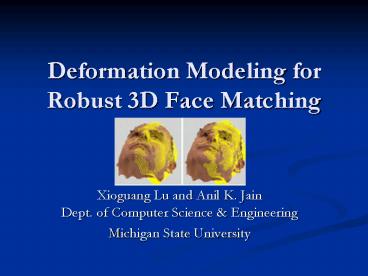Deformation Modeling for Robust 3D Face Matching - PowerPoint PPT Presentation
1 / 15
Title:
Deformation Modeling for Robust 3D Face Matching
Description:
... Modeling for Robust 3D Face Matching. Xioguang Lu and Anil K. ... Register non-neutral scan with neutral scan of same face to estimate landmark displacement ... – PowerPoint PPT presentation
Number of Views:80
Avg rating:3.0/5.0
Title: Deformation Modeling for Robust 3D Face Matching
1
Deformation Modeling for Robust 3D Face Matching
- Xioguang Lu and Anil K. JainDept. of Computer
Science Engineering - Michigan State University
2
Problem
- Although 3D facial scans do not vary with
lighting or pose changes, nonrigid facial
deformations can hurt recognition - Collecting and storing multiple expression
template scans for each subject is not practical - Expressions can have differing intensities
3
Proposed Scheme
- A (hierarchical) geodesic sampling is used to
quantify facial expression - Expression variations are learned from a small
control group - These variations are used to create a deformable
model from gallery templates - This deformable model is fit to the target scan
and matching distance computed
4
(No Transcript)
5
Sampling
- Landmarks are manually selected (nose tip, eye
corners, mouth corners, and mouth contour) - Geodesic distance between certain features is
computed (hierarchically in latest work) - Geodesics are split into L segments of equal
length to generate L-1 new feature points
6
Deformation Transfer
- Register non-neutral scan with neutral scan of
same face to estimate landmark displacement - Establish a mapping F from the neutral gallery to
the neutral target face - Use F to transfer landmarks in the non-neutral
gallery scan to the (synthesized) non-neutral
target - Establish a mapping ? from the neutral to
non-neutral target - Interpolate ? using thin-plate-spline mapping
- Boundary constraints are included in
thin-plate-spline calculation as additional
landmark points
7
Registration
- Neutral and non-neutral target are aligned using
features which dont move much with expression
changes, such as eye corners and nose tip - This separates rigid transformations from
nonrigid transformations
8
Thin-Plate Splines
- Goal find a mapping from landmark set U to V
with known correspondences - Method imagine V as a thin metal sheet and find
a function which minimizes bending energy - Solution F(u) c Au WTs(u)
- s(u) (u u1, u u2, )T
- An analytical solution can be obtained for 3D
points
9
Deformable Model Construction
- To generate a deformable model, each learned
expression is simulated on a neutral gallery face - Face is represented as a combination of shape
vectors - M is the number of synthesized templates, ai is
the weight of each template - By adjusting the weights ai, various combinations
of expressions can be generated - To reduce computational complexity, one
deformable model per expression is generated
10
Matching
- Coarse alignment performed as during deformation
transfer - Alignment refined with iterative closest point
algorithm - Associate each point with nearest neighbor,
calculate transform to minimize distance, repeat - Minimize a cost function by solving for ais
- R and T are rotation and translation matrices, S
is the deformable model, and St is the test scan - Use these ais to compute a new iterative closest
point distance, and return to step 2 until
convergence
11
Experiment I
- Self-collected database of 10 subjects at 3
different poses, with 7 different expressions,
for 210 total scans and 10 gallery models - 5 subjects at random chosen as control group,
leaving 105 scans for recognition - Results
12
Experiment II
- Control group 10 subjects from Experiment I
- Test group 90 additional subjects, with 6 scans
each at different viewpoints (in most cases) - 533 total test scans
- Results
13
Experiment III
- A subset of FRGC v2.0 dataset
- Scans with the earliest timestamp and neutral
expression are used as templates - 50 gallery scans, 150 test scans
- 10 subjects in Experiment I used as control group
- Latest results (after publication)
14
Conclusions
- One area for improvement (noted in the paper) was
the dependence on manual landmark labeling - Also, I thought that there might be some
application of geometric invariants to replace
their registration step (which is subject to
local minima)
15
Questions?































